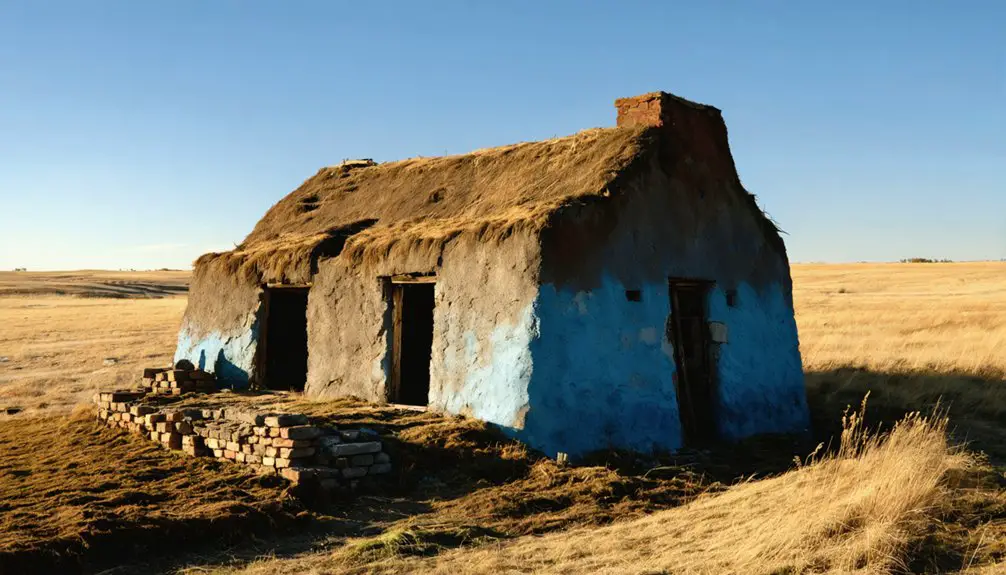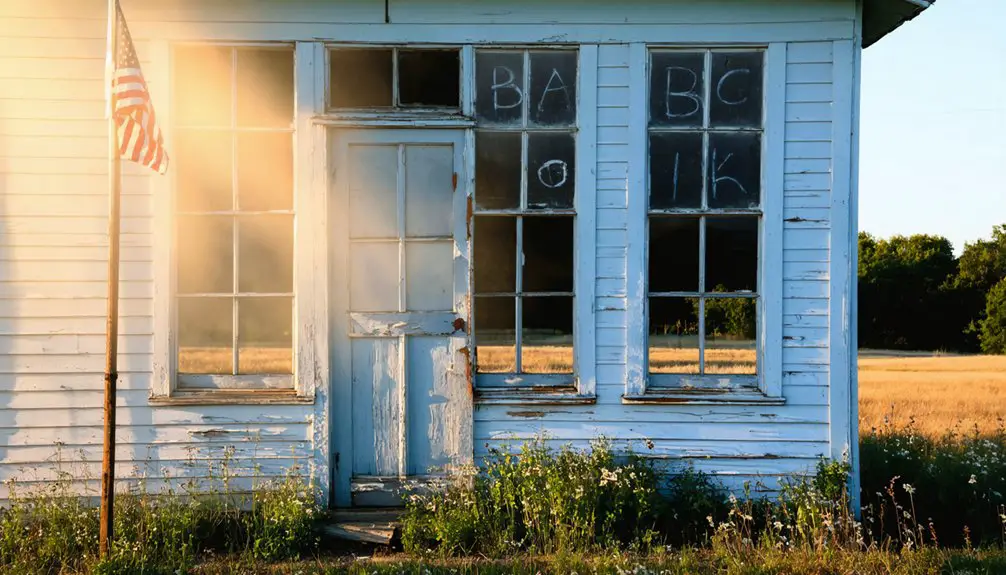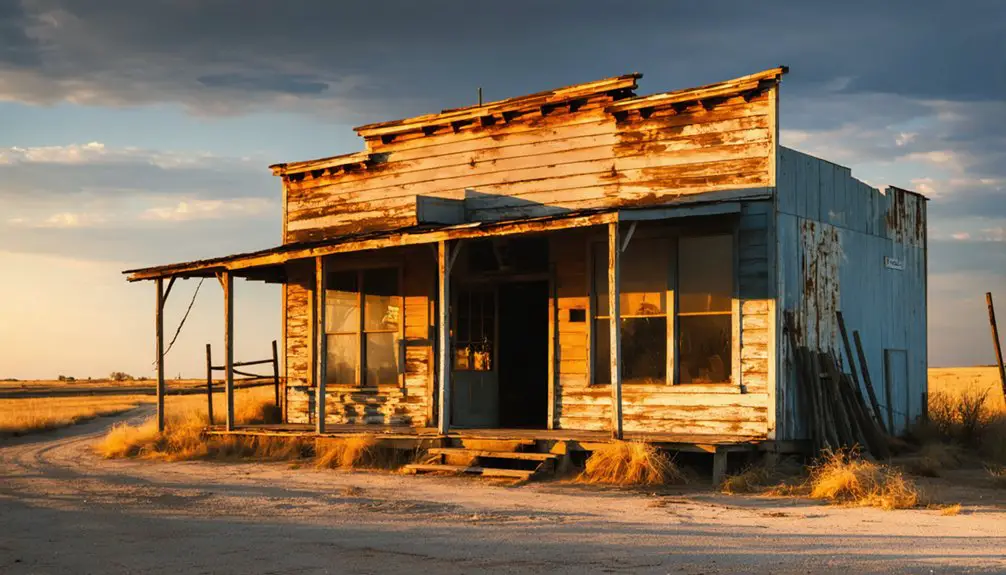You’ll find Cowboy Flats, Oklahoma along the old cattle trails where line riders once managed vast herds from dugouts. Initially a bustling frontier hub, the settlement changed its name to Pleasant Valley in 1904 after establishing its first post office. The town became infamous as the Dalton Gang‘s final meeting spot before their Coffeyville raid. While the buildings have crumbled into the prairie, scattered artifacts still tell tales of frontier justice, sod houses, and vigilante committees.
Key Takeaways
- Originally named Cowboy Flats due to cattle grazing lands, the settlement later became Pleasant Valley after its post office opened in 1904.
- The town served as the last gathering place for the notorious Dalton Gang before their ill-fated Coffeyville raid.
- Residents built homes using durable Blue Creek sod blocks, creating structures that could withstand harsh prairie conditions.
- The community featured saloons, a general store, and blacksmith, thriving during the cattle drive era before transportation improvements.
- Today, only scattered remnants and foundations remain, with the land primarily used for agriculture and crossed by dirt roads.
From Pleasant Valley to Cowboy Flats: A Name’s Evolution
While cattle drivers knew the area simply as Cowboy Flats due to its prime grazing lands, the settlement’s name evolved alongside its development in the late 19th century.
The cultural identity of this frontier outpost began shifting when the first post office opened in nearby Campbell on January 29, 1900, initially named Anna.
The historical significance of the area deepened as it changed from a rugged cattle stop to an established community, marked by the official name change to Pleasant Valley on February 29, 1904.
The area gained notoriety as the last meeting place of the infamous Dalton gang before their ill-fated Coffeyville raid.
Local cowboys had established themselves as sooners in the region before the 1889 land run, working together to secure their claims.
You’ll find that this evolution reflected the broader transformation of the region, as the wild frontier atmosphere of Cowboy Flats gave way to a more settled community identity that would last until the post office’s closure in 1947.
Life in Sod Town: Early Settlement Days
When settlers first arrived in northeastern Logan County’s Cowboy Flats, they encountered a semi-arid landscape that demanded resourcefulness and determination.
You’d have found early residents living in modest one-room structures and sod houses, often partially underground to withstand harsh weather conditions. These frontier families banded together, helping each other stake claims and manage cattle herds across the open plains.
Life centered around community gatherings in local saloons, where Irish railroad workers and cowboys would exchange stories and information. Under the Homestead Act, settlers could claim 160 acres if they lived on and improved the land for five years.
The saloon served as more than a tavern – it was the heartbeat of frontier life, where workers shared tales and vital news.
You’d witness neighbors supporting one another through legal battles over land claims, particularly involving “sooners” who’d entered illegally.
Despite the challenges of drought, harsh winters, and limited water access, these pioneers forged ahead, building a self-reliant community around cattle grazing and small-scale farming. Like many Oklahoma settlers in the late 1800s, they established a self-governing territorial board to maintain order and create basic laws.
The Wild West Meets Law and Order
As you walk through Cowboy Flats’ rugged terrain, you’ll find remnants of an era when the Anti-Horse Thief Association conducted swift midnight trials under “the courtroom” oak tree.
You’re standing where outlaw gangs once exploited the vast grasslands and rocky canyons, prompting local settlers to demand stronger protection against horse thieves and cattle rustlers.
In those untamed days, you’d commonly see cowboys carrying six-shooters even in schoolhouses, reflecting the raw reality of frontier justice before formal law enforcement took root.
The notorious Bill Dooling gang frequently terrorized these parts, adding to the area’s reputation for lawlessness and danger.
The landscape features numerous caves with carved dates from visitors dating back to 1875, silently preserving the signatures of those who passed through this historic territory.
Vigilantes Take Swift Action
During the lawless frontier days of Cowboy Flats, vigilante groups emerged to fill the void left by absent formal law enforcement. With strong community support, these self-appointed committees conducted investigations and swift trials, often meeting at midnight or in symbolic locations like “the courtroom” tree. The vigilantes held mock public trials before carrying out punishments against accused criminals. Like other frontier settlements, these groups formed because the local authorities were weak or intimidated by criminal elements.
You’d find them taking decisive action against horse thieves, rustlers, and other criminals who threatened the safety of settlers and homesteaders.
Their methods were harsh but effective – ranging from banishment to hanging – aimed at deterring further lawlessness. While controversial, vigilante justice became the de facto authority in Cowboy Flats, as residents banded together to protect their families and property.
Without formal courts or government presence, these groups maintained order during the critical early settlement period.
Outlaw Gangs Roam Free
The Dalton Gang’s reign of terror cast a dark shadow over Cowboy Flats and the Oklahoma Territory from 1890 to 1892.
Led by brothers Bob, Grat, and Emmett Dalton, along with Bill Power and Dick Broadwell, they’d staked claims near Cowboy Flats before turning to a life of crime. The brothers had once served as U.S. Deputy Marshals before becoming outlaws. Their ancestors had traveled from France to Ireland before finally settling in Kentucky. You’d find their gang hideouts scattered throughout the region, particularly northeast of Guthrie.
The gang’s most notorious heist netted $17,000 in Adair, leaving dead guards and bystanders in their wake.
With $5,000 bounties on their heads, they planned an unprecedented dual bank robbery in Coffeyville, Kansas.
Other outlaw legends like “Zip” Wyatt made the area infamous, operating from camps south of the Cimarron River.
Pioneer families lived in constant tension, never knowing when they’d encounter these dangerous men.
Six-Shooters in School
While frontier schools sought to bring civilization to Oklahoma Territory‘s untamed lands, you’d find an unusual sight hanging alongside coats and hats on classroom walls – students’ six-shooters.
In these rough-hewn, one-room schoolhouses, armed education became the norm as older students carried pistols for frontier safety against the dangers lurking beyond classroom walls.
You’d witness a stark contrast between reading lessons and the realities outside, where horse thieves and outlaws gathered at nearby saloons.
The presence of firearms reflected the delicate balance between maintaining order and acknowledging the Wild West‘s harsh truths.
In these remote settlements, where law enforcement was scarce, schools adapted to an environment where personal security went hand-in-hand with learning arithmetic and spelling.
Building With Blue Creek Sod: Frontier Architecture

You’ll find Blue Creek sod buildings were constructed by stacking thick rectangular blocks cut from the dense, root-filled prairie soil, creating walls up to 2 feet thick without mortar.
The buildings’ dark interiors and rough-hewn wooden window frames reflected the harsh realities of frontier construction with limited materials.
Despite their primitive appearance, these sod structures proved remarkably durable against prairie weather, keeping inhabitants cool in summer and warm in winter through natural insulation.
Construction Methods and Materials
During frontier settlement of Cowboy Flats, Blue Creek sod emerged as the primary building material due to its abundant availability and structural qualities.
You’d harvest thick prairie grass blocks, typically 12″ x 24″ and 4-6″ thick, using specialized sod knives or plows. These dense root mats provided natural binding for structural integrity.
To build, you’d stack sod blocks in overlapping patterns, similar to bricklaying, creating walls one to two blocks thick. The architectural innovations included reinforcing corners with vertical logs or stones, while timber rafters supported sod-covered roofs.
Sod preservation techniques often involved plastering interior walls with clay or lime to control dust and enhance comfort. The resulting structures offered excellent insulation, though they required regular maintenance to combat erosion and structural settling.
Durability Against Prairie Elements
Because of its remarkable adaptation to prairie conditions, Blue Creek sod buildings demonstrated exceptional durability against harsh frontier elements.
You’ll find the secret to their sod resilience in the dense root systems that extended 6 to 12 feet deep, creating natural stability against wind and rain. These prairie structures didn’t need chemical treatments or artificial protections – they thrived through evolved resilience.
The buildings’ durability came from the natural properties of Blue Creek’s alkaline-adapted grasses and sedges.
You could count on the rhizomatous growth patterns to maintain structural integrity, while the vegetation’s quick establishment protected against erosion.
Even in water-logged conditions, the prairie sod’s ability to stabilize soil and manage moisture made these structures remarkably resistant to the region’s unforgiving climate.
Daily Life in a Rough-and-Tumble Town
Life in Cowboy Flats reflected the raw nature of frontier existence, where locals navigated through a community built of blue creek sod and marked by minimal infrastructure.
You’d find cowboy camaraderie in the town’s two saloons, where pool halls served as social hubs amid the rough routines of daily survival.
While cattle grazed on surrounding grasslands, cowboys would rest and resupply at the lone store or visit the blacksmith.
You’d need to watch your step between buildings, where refuse accumulated unchecked, and keep your wits about you – even students carried six-shooters to school.
Though horse thieves and outlaws frequented the area, there was an unwritten code: you didn’t steal from friendly neighbors.
Without formal law enforcement, you’d rely on vigilante justice and self-policing to maintain order in this untamed settlement.
The Chitwood Gang and Other Notable Characters

Among the most notorious outlaws you’d find in Cowboy Flats was the Chitwood Gang, whose members specialized in horse theft and ran a profitable moonshine trade into Cherokee Outlet.
You’d hear tales of their loose code of ethics, avoiding theft from friendly neighbors, though this didn’t prevent local vigilantes from killing one member and driving others out of the region.
Law enforcement challenges in the area meant you’d often witness citizen justice taking over, with groups like the Respective Claims Board, backed by armed men with Winchesters, stepping in to maintain order.
Notorious Gang Members’ Activities
During the lawless era of Oklahoma’s Panhandle, two notorious outlaw groups dominated the criminal landscape: the Chitwood Gang and the Coe Gang.
The Chitwood Gang, operating from Old Sod Town, built their reputation on horse thievery and moonshine trade. They’d steal four-legged livestock from neighboring areas while maintaining an unusual code – they wouldn’t target those who treated them well.
Meanwhile, the Coe Gang, led by William Coe, established their base at Robbers’ Roost in Black Mesa. With 30 to 50 members, they’d raid army horse and mule herds across New Mexico and Colorado.
Their hideout featured luxuries like a bar and piano, until an 1867 army attack with cannon fire ended their reign.
The outlaw culture thrived until vigilante justice and military intervention finally brought these gangs to their end.
Law Enforcement’s Constant Battle
While lawmen struggled to maintain order in Oklahoma Territory, the fragmented jurisdiction created by the Courts Act of 1883 complicated their efforts against the Chitwood Gang and other outlaws.
The territory’s law enforcement tactics evolved when E.D. Nix became U.S. Marshal in 1889, bringing a fresh approach to combating criminal activity.
You’d find The Three Guardsmen – Heck Thomas, Bill Tilghman, and Chris Madsen – leading posses and coordinating raids to disrupt outlaw operations. They’d employ bounty hunters and informants to track gang movements, particularly in lawless areas like No Man’s Land.
Despite their effectiveness, these lawmen weren’t without controversy. Some, like Tilghman, blurred ethical lines between law enforcement and illegal activities.
The outlaws’ impact forced authorities to adapt, leading to more organized responses and the eventual incorporation of ungoverned territories under formal jurisdiction.
Saloon Showdowns and Hangings
Saloon confrontations and vigilante justice defined the lawless atmosphere of Cowboy Flats, where the Chitwood Gang‘s ruthless activities pushed citizens to take matters into their own hands.
Operating from Old Sod Town, the gang’s horse thefts and moonshine trade across Indian Territory sparked fierce retaliation from locals. Saloon etiquette meant little in these establishments, where whiskey-fueled tensions often erupted into violent shootouts.
When formal law enforcement failed, vigilante tactics took over. Accusations of theft frequently led to horseback juries conducting nighttime trials, followed by swift hangings.
The Anti-Horse Thief Association‘s Goodnight chapter influenced these practices, while strategic hideouts gave outlaws temporary refuge.
You’ll find echoes of these turbulent times preserved at Rollins Creek Old West Town, where authentic memorabilia recalls an era when frontier justice ruled the Oklahoma Panhandle.
Education on the Edge: The One-Room Schoolhouse

As pioneers ventured west into remote territories, one-room schoolhouses became crucial pillars of rural education across America.
You’d find these simple rectangular buildings with large windows serving multiple grades, where a single teacher managed everything from reading and arithmetic to moral lessons using McGuffey Readers.
Beyond education, these schoolhouses transformed into important community hubs where you’d gather for town meetings, church services, and Christmas pageants.
Your family would contribute through school taxes and volunteer support, often providing firewood or housing for teachers.
While poorly equipped with basic heating and primitive sanitation, these schools persisted.
Economic Rise and Fall Along the Cimarron
Beyond the schoolhouse doors, another story unfolded in Cowboy Flats – one of economic prosperity tied to the region’s rich grasslands. You’d find thousands of cattle grazing across Pleasant Valley, where cowboys drove their herds northward along routes like the Chisholm Trail.
The Cimarron River, though not navigable, provided essential water stops for both cattle and settlers.
In the early 1900s, you’d witness Cowboy Flats at its peak, bustling with cattle drives and seasonal ranching activity. Line riders managed the herds from dugouts while local businesses served the needs of passing cowboys.
But as transportation networks improved, you’d see the town’s importance fade. Cattle drivers could travel farther and faster, bypassing traditional stops, leading to Cowboy Flats’ economic decline and eventual abandonment.
Transportation’s Role in the Town’s Decline
The arrival of the Eastern Oklahoma Railway in 1900 marked a pivotal turning point for Cowboy Flats, initially bringing prosperity through two daily passenger trains and regular freight service.
The railroad’s arrival in 1900 transformed Cowboy Flats from sleepy outpost to bustling hub, as trains brought new life daily.
You’d have found Irish railroad workers settling in the area, establishing businesses and bringing energy to the community along the rail line.
But when America shifted from rails to automobiles, Cowboy Flats’ isolation became apparent.
Without adequate transportation infrastructure linking it to major highways, the town’s economic decline accelerated.
The railway’s abandonment in 1959 dealt the final blow – you’d no longer see the steady flow of goods, services, and people that once kept the town alive.
Former railroad employees moved away, businesses shuttered, and the empty rail depot stood as a silent reminder of more prosperous times.
The Ghost Town’s Physical Legacy Today
Walking through Cowboy Flats today, you’ll find only scattered remnants of what was once a bustling railway town. Dilapidated wooden structures and stone foundations peek through the grasslands, while historical remnants like old tools and fence posts dot the landscape.
The Cimarron River still flows north of the site, overlooking pastoral plains where cattle once grazed. You won’t find any functioning buildings or organized community here. Instead, ghostly artifacts occasionally surface, telling stories of early 1900s life through discovered headstones and building debris.
The land has largely returned to agricultural use, with dirt roads winding through private properties. While some artifacts rest in local museums, most physical evidence remains hidden in the Oklahoma soil, waiting to be uncovered by time and weather.
Frequently Asked Questions
Were There Any Famous Shootouts or Gunfights at Cowboy Flats’ Saloons?
You won’t find documented famous gunfight legends or verified saloon tales here. While rough characters frequented the area, historical records don’t confirm any notorious shootouts in this frontier settlement.
What Happened to the Families Who Lived There After the Town Declined?
Like scattered seeds in the wind, you’d find these families relocated to nearby towns with better opportunities, seeking railroad connections, functioning schools, and stable jobs. Some preserved ghost town stories through generations.
Did Any Native American Tribes Interact With Cowboy Flats Settlers?
You’ll find the Wichita and Affiliated Tribes had cultural exchanges with settlers through limited trade relations, though tensions existed over land rights during the late 1800s settlement period.
What Was the Highest Recorded Population of Cowboy Flats?
You won’t find a definitively recorded highest population for this settlement, though historical significance suggests several hundred residents at its peak, based on typical patterns of similar Oklahoma frontier towns.
Were There Any Successful Businesses That Relocated From Cowboy Flats?
Like a tumbleweed rolling away, you won’t find any documented successful business relocations. There’s no evidence of lasting enterprises that moved elsewhere, as the town’s economic impact centered on temporary cattle-drive activities.
References
- https://www.rideok.com/sod-town-ghost-town-in-the-oklahoma-panhandle/
- https://www.rideok.com/pleasant-valley-oklahoma-ghost-town/
- https://okmag.com/blog/gone-but-not-forgotten/
- https://en.wikipedia.org/wiki/List_of_ghost_towns_in_Oklahoma
- https://abandonedok.com/lenapah-ok/
- https://www.youtube.com/watch?v=babPmmM4JNo
- https://www.ghosttowns.com/states/ok/campbell-pleasantvalley-cowboyflats.html
- https://kids.kiddle.co/List_of_ghost_towns_in_Oklahoma
- https://en.wikipedia.org/wiki/Oklahoma_panhandle
- https://www.nps.gov/parkhistory/online_books/chickasaw/pdf/Chapter 2.pdf



